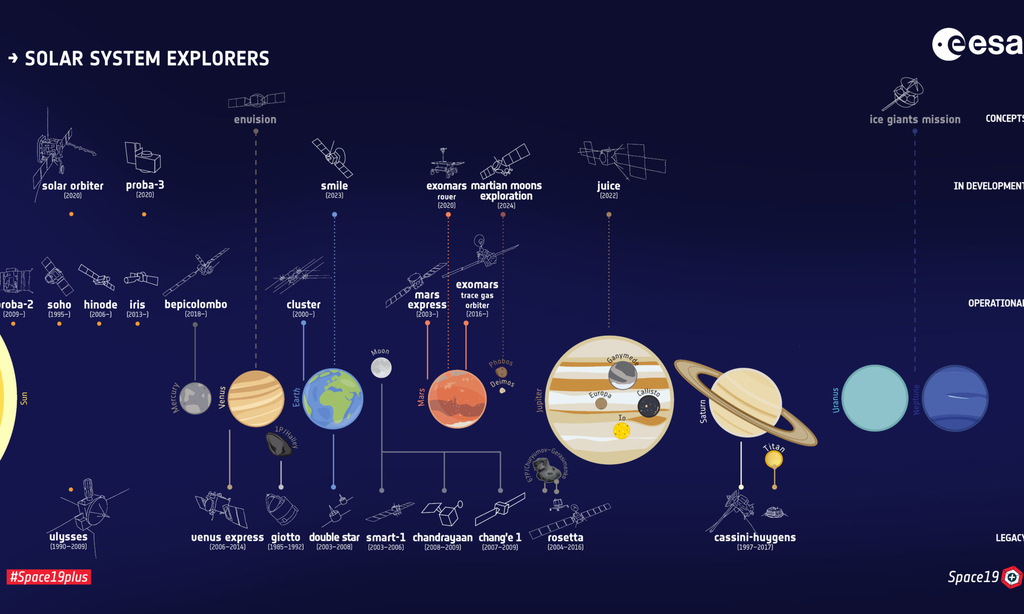Plans to explore the Solar System: it's getting crowded

Our understanding of our closest companions in space is far from complete: there are 8 planets, over 200 moons and many more small objects like dwarf planets, asteroids and comets to look at. Space agencies have already sent out over 250 probes, and more are yet to come.
The Juno mission just conducted its closest fly-by to one of Jupiter’s numerous moons, Ganymede. Such precise images were last obtained with the Galileo spacecraft in 2000, but that probe ended its mission in 2003. The European Space Agency's Jupiter Icy Moons Explorer mission (JUICE) is set to launch in a year from now, however it will take another 7 years for the probe to reach the proximity of Jupiter. Until then, Juno is the best tool astronomers have to get data about the curious moon as well as other parts of the Jovian system, as it carries instruments able to observe targets in the radio, microwave, infrared, optical and ultraviolet bands.

Ganymede by Juno 
Ganymede by Galileo
From these images, astronomers hope to get an insight into the chemical composition of lighter and darker patches at Ganymede’s surface. Other mysteries about this moon, larger than Mercury, is its magnetic field, as it is the only moon in the Solar System to possess one. Juno is set to finish its operations in September 2025, which potentially gives enough time for it to do another fly-by, although the mission has many other aims like the study of Jupiter’s auroras and its magnetic field, mapping its gravity field, or even take close-up image with JunoCam.
Astrobiology is most often a hot topic when talking about Mars, however Jupiter’s moons are also exciting, as Europa, Ganymede and Callisto may contain vast oceans of liquid water below their icy surfaces. From our current understanding of how life can evolve, we expect that lifeforms need such a liquid medium to develop. More recently, investigations have considered Venus too – you might have followed the story of phosphine that was detected in the Venusian atmosphere, which is a molecule that appears in terrestrial biological processes but could also be produced chemically; to support life there, the liquid medium would have to be droplets composed of 90% sulphuric acid, something very exotic! Anyway, there is a lot of uncertainty about these results, and Venus is overall less well understood than, e.g., Mars as less probes have been sent there. This is partly due to technical challenges, first and foremost the extreme heat on Venus’ surface, on average 464 °C thanks to its dense atmosphere that creates strong greenhouse effects.
The two missions that have been selected by NASA to reach Venus by 2030, the first ones since the USSR’s in 1985, are DAVINCI+ and the VERITAS orbiter. They will study the planet’s atmosphere, notably in search of phosphine, and its geological and volcanic activity respectively. ESA, too, has selected a programme, the EnVision orbiter, to study Venus’ geological and atmospheric processes. A key question is how Venus has changed from a potentially habitable, or even inhabited, planet in the early Solar System, to the furnace we observe now.

DAVINCI's fall towardss Venus: it will have a slow descent to conduct measurements, then crash onto the surface 
Veritas using radar remote sensing to probe Venus' surface
Added to that, India and Russia are also planning spacecrafts to Venus: the first country’s Shukrayaan orbiter is a four-year mission with planned launch in 2024, which will similarly to EnVision carry instruments able to study both the surface and the atmosphere at various wavelengths. Russia is designing a nuclear-powered spacecraft, Zeus, that would travel to the Moon, Venus and Jupiter in about 4 years, possibly with cosmonauts on board, as early as in 2030.

As you can see on the cover image, the Solar System is getting crowded by space probes.
Getting to know our planetary neighbours better is essential, especially for astrobiology studies. There are many more upcoming missions to other parts of the Solar System not mentioned here, including studies of asteroids and the Sun itself. Some space agencies like Roscosmos or the Chinese National Space Agency have a clear focus on manned missions, while NASA’s primary focus, for its astronauts, is a return to the Moon.
Cover image: Probes in the solar system, O. Frohn
Image credits:
1 - Ganymede, NASA/JPL-Caltech/SwRI/MSSS
2 - Ganymede, NASA/JPL
3 - Juno mission poster, NASA/JPL
4 - JUICE mission poster, ESA
5 - DAVINCI+, NASA GSFC visualization and CI Labs, M. Lentz and colleague
6 - VERITAS, NASA/JPL-Caltech
7 - ESA solar system explorers, ESA


